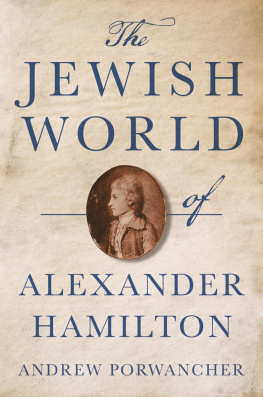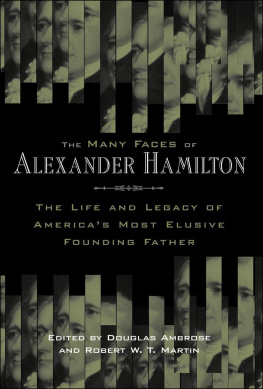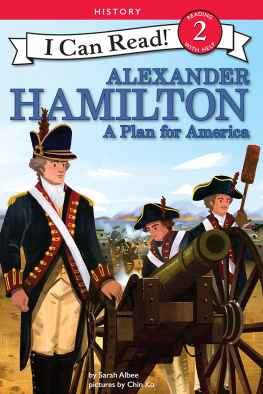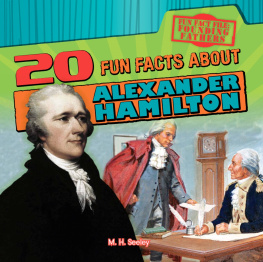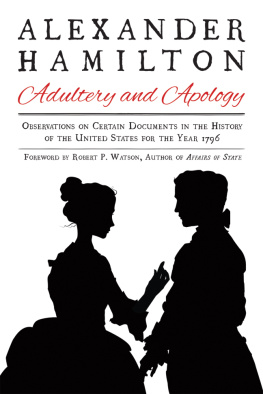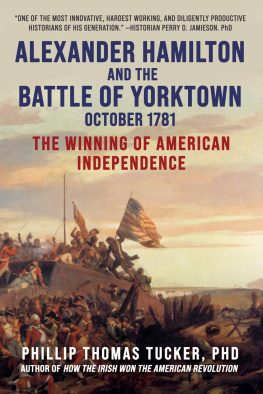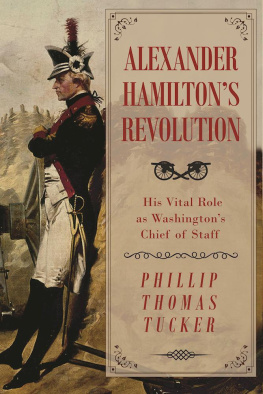THE JEWISH WORLD OF ALEXANDER HAMILTON
The Jewish World of Alexander Hamilton
ANDREW PORWANCHER
PRINCETON UNIVERSITY PRESS
PRINCETON & OXFORD
Copyright 2021 by Princeton University Press
Princeton University Press is committed to the protection of copyright and the intellectual property our authors entrust to us. Copyright promotes the progress and integrity of knowledge. Thank you for supporting free speech and the global exchange of ideas by purchasing an authorized edition of this book. If you wish to reproduce or distribute any part of it in any form, please obtain permission.
Requests for permission to reproduce material from this work should be sent to
Published by Princeton University Press
41 William Street, Princeton, New Jersey 08540
6 Oxford Street, Woodstock, Oxfordshire OX20 1TR
press.princeton.edu
All Rights Reserved
Library of Congress Cataloging-in-Publication Data
Names: Porwancher, Andrew, author.
Title: The Jewish world of Alexander Hamilton / Andrew Porwancher.
Description: Princeton : Princeton University Press, [2021] | Includes bibliographical references and index.
Identifiers: LCCN 2021009022 (print) | LCCN 2021009023 (ebook) | ISBN 9780691211152 (hardback) | ISBN 9780691212708 (ebook)
Subjects: LCSH: Hamilton, Alexander, 17571804Religion. | ProtestantismSocial aspectsUnited StatesHistory17th century. | JudaismSocial aspectsUnited StatesHistory17th century. | JudaismSocial aspectsNevisHistory17th century. | Statesmen Religious lifeUnited StatesHistory18th century. | United States Politics and government17751783. | United StatesPolitics and government17831809. | New York (N.Y.)Biography. | Nevis Biography. | BISAC: HISTORY / United States / Revolutionary Period (17751800) | POLITICAL SCIENCE / History & Theory
Classification: LCC E302.6.H2 P67 2021 (print) | LCC E302.6.H2 (ebook) | DDC 973.4092 [B]dc23
LC record available at https://lccn.loc.gov/2021009022
LC ebook record available at https://lccn.loc.gov/2021009023
Version 1.0
British Library Cataloging-in-Publication Data is available
Editorial: Fred Appel, James Collier
Jacket Design: Henry Sene Yee
Production: Erin Suydam
Publicity: Kate Hensley, Kathryn Stevens
Copyeditor: Don Burgard
Jacket art: Photograph of miniature watercolor and ink portrait of Alexander Hamilton at age fifteen, drawn from life, January 11, 1773 / Library of Congress.
Background texture: Shutterstock
In memory of Arthur Mogilesky
In Jewish history, there are no coincidences.
ELIE WIESEL
FIGURES
ACKNOWLEDGMENTS
I OWE MY FIRST debt of gratitude to the great Rabbi Dr. Meir Solly Soloveichik. When we initially met over breakfast on the Upper West Side in the early days of my research for this book, Solly told me that he would help me in any way. Indeed, no other scholar has done more to make this book a reality. As the rabbi of Congregation Shearith Israel, he is the leader of Americas oldest Jewish congregation, whose membership in the early years of the republic had numerous ties to Alexander Hamilton. Im appreciative for his inexhaustible enthusiasm and deep knowledge of Jewish history. I had the pleasure of spending a semester on sabbatical as a senior research fellow under Sollys auspices at the Zahava and Moshael Straus Center for Torah and Western Thought at Yeshiva University, and I am grateful to the Straus family. Happily, my time at the Straus Center coincided with its Program on Early America and the Jews. Robert and Ellen Kapito merit special attention for their generosity and support of this project. Thank you also to Rabbi Dr. Stu Halpern and Rabbi Aryeh Czarka, who both helped facilitate my involvement with the Straus Center.
Princeton University Press has been a wonderful publisher to work with, owing in large part to the efforts of my editor there, Fred Appel. He is just the kind of attentive and thoughtful editor for whom an author hopes. Many thanks to the rest of the team at Princeton University Press for their efforts in bringing this book to fruition. The anonymous reviewers provided helpful feedback on the manuscript. Thomas LeBien immeasurably improved the project with his insights.
I was fortunate to spend a semester down the street from the press while on sabbatical at the James Madison Program, housed within Princeton Universitys Department of Politics, where I served as the Garwood Visiting Fellow. Im grateful to the program leadershipProfessor Robert George and Dr. Bradford Wilsonfor the opportunity. The fellowship provided me with critical time to write and the company of a wonderful cohort of fellows. I grew up in the town of Princeton and perhaps have the unique distinction among visiting scholars in the universitys long history of having an office on the same street as my childhood home. At the age of twelve, I snuck into the universitys football stadium with some friends. When a security guard apprehended us, he informed us that we had a lifetime ban from the campus. If he caught wind of my return to the university during my fellowship, I wish now to express my thanks to him for extending me clemency with his silence.
I am deeply appreciative for the support of a number of scholars at the University of Oklahoma. Foremost among them is Alan Levenson, director of the Schusterman Center for Judaic and Israel Studies. Alan was the first historian anywhere whom I consulted about this undertaking, and he can testify that I actually did begin my research before the Hamilton musical debuted. Wilfred McClay advocated for me time and again over the course of the project; he is as generous as they come. Oklahoma is home to a rich cohort of scholars across multiple disciplines with a strong interest in religious history, and Ive been fortunate to call many of them friends, especially David Anderson, Scott Fitzgerald Johnson, Louis Cortest, Kyle Harper, and Jill Hicks-Keeton. I had the pleasure of taking up a fellowship at the OU Humanities Forum under the leadership of Janet Ward and thank her for her tireless efforts. This project also received support at OU from the Institute for the American Constitutional Heritage, the Department of Classics and Letters, the Digital Scholarship Lab at Bizzell Memorial Library, and the College of Arts and Sciences. Thanks as well to my diligent research assistants: Elizabeth Bagwell, Austin Coffey, and Rachel Averitt.
The preparation and publication of this volume was made possible by a grant from the Memorial Foundation for Jewish Culture. The Gilder Lehrman Institute of American History awarded me a research fellowship to subsidize my archival work. The American Jewish Historical Society named me the Sid and Ruth Lapidus Fellow, which allowed me to undertake research in its collections; I am particularly indebted to the staff at the Center for Jewish History for its assistance. The George Washington Institute for Religious Freedom and Dr. Michael Feldberg provided resources when I first began this endeavor.
Much gratitude to the countless librarians and archivists across the United States, the Caribbean, and Europe who assisted me, particularly at the Library of Congress, the Danish National Archives, the British Library, the Columbia Rare Book and Manuscript Library, the New York Historical Society, the New York Public Library, the New York State Archives, the American Jewish Archives, the Nevis Historical and Conservation Society, and the Research Library and Archives at Estate Whim. Andrew Fagal deserves many thanks for his close reading of several chapters. Dan Gerstle generously gave me his considered comments on the entire manuscript. Professor Stephen Knott extended this book the benefit of his vast expertise on Hamilton. Thanks as well to Professor Robert Paquette for hosting me at the Alexander Hamilton Institute. David Lynch shared his thorough knowledge of the records on St. Croix. Nathan Carr lent me his insights into religious rites. Any merit there may be in this book is due in large part to all those aforementioned; any errors are mine alone.

